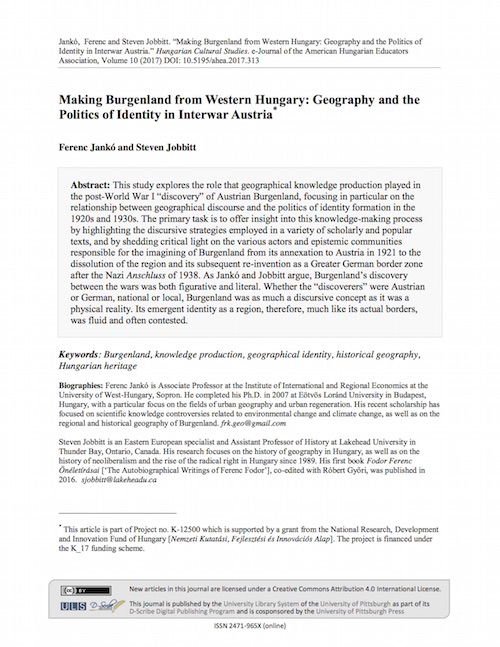New Publication Explores Post-World War I Austrian Burgenland
Assistant Professor Steven Jobbitt’s latest publication explores the role that geographical knowledge production played in the post-World War I “discovery” of Austrian Burgenland. Co-written with Ferenc Jankó of the University of West-Hungary, Sopron, "Making Burgenland from Western Hungary: Geography and the Politics of Identity in Interwar Austria" appears in the current issue of Hungarian Cultural Studies.
Abstract: This study explores the role that geographical knowledge production played in the post-World War I “discovery” of Austrian Burgenland, focusing in particular on the relationship between geographical discourse and the politics of identity formation in the 1920s and 1930s. The primary task is to offer insight into this knowledge-making process by highlighting the discursive strategies employed in a variety of scholarly and popular texts, and by shedding critical light on the various actors and epistemic communities responsible for the imagining of Burgenland from its annexation to Austria in 1921 to the dissolution of the region and its subsequent re-invention as a Greater German border zone after the Nazi Anschluss of 1938. As Jankó and Jobbitt argue, Burgenland’s discovery between the wars was both figurative and literal. Whether the “discoverers” were Austrian or German, national or local, Burgenland was as much a discursive concept as it was a physical reality. Its emergent identity as a region, therefore, much like its actual borders, was fluid and often contested.
Reference: Ferenc Jankó and Steven Jobbitt. "Making Burgenland from Western Hungary: Geography and the Politics of Identity in Interwar Austria." Hungarian Cultural Studies 10 (2017): 14-40. DOI: 10.5195/ahea.2017.313


